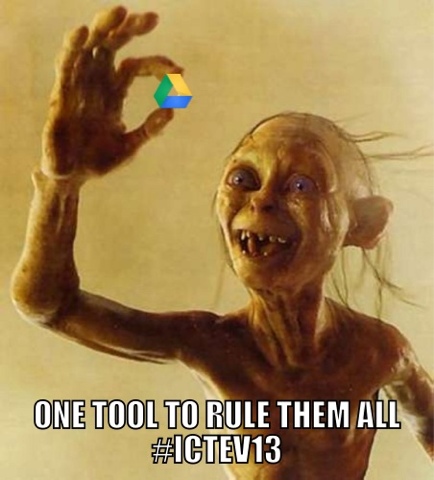This is a summary of the workshop that I presented at ICTEV13: IT Takes a Village
Discovery often starts with a problem. My problem was the use of mundane exercise books and worksheets. After exploring different potentials (Microsoft Word, Evernote and the Ultranet), I finally introduced Google Drive.
Some examples of how Drive has been used to transform learning include:
- access everywhere. With student laptops often re-imaged, work is not only continually backed up, but also accessible from any computer.
- the opportunity to work collaboratively. Some examples have included adding to a single document for book clubs, sharing student goals to all relevant stakeholders and staff working together on a curriculum document.
- the ability to provide flexible feedback. Whether it is a teacher commenting on a workbook anytime, students posing questions on a presentation or using Forms to ascertain different points of information.
On the other side of the coin, there are always hurdles faced when introducing a new application. Although students are usually quick to jump into the potential of new technologies, staff often question why they need to change, just look at the Ultranet. In addition to this, some staff feel that other applications offer more potential.
In the end, the question that remains is that if Google is not the tool to rule them all, then what? I’m ok with not using Google, but doing nothing is no longer an option.
Also published in Term 3 ICTEV Newsletter
If you enjoy what you read here, feel free to sign up for my monthly newsletter to catch up on all things learning, edtech and storytelling.
In Search of One Tool to Rule Them All? by Aaron Davis is licensed under a Creative Commons Attribution-ShareAlike 4.0 International License.


Wonderful summary of your ICTEV talk this year. Thank you for sharing.
@mrkrndvs in 2016, the most powerful tool for me is OneNote ClassNotebooks – the most flexible and collab digi canvas for learning #msauedu
@ray_trent whats interesting is that OneNote was not necessarily the product it is today in ’13. Mayb the phrase shd b: one tool 2 rule 2day
@mrkrndvs this is true! I wonder what will be the tool to rule all tomorrow!? Hehe
Microsoft OneNote is truly awesome.